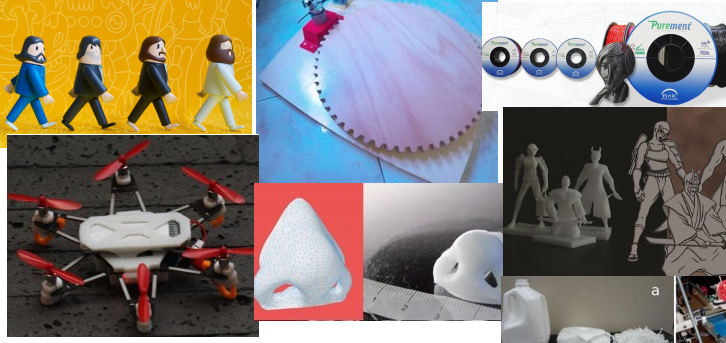This week’s news we didn’t cover kicks off with a topic that so many printing enthusiasts love: printable figures inspired by artistic characters. We have printable robot files included with a new Polish sci-fi novel, figurines that accompany a Japanese board/video game, and none other than 3D printed Beatles figures based on the famous “Abbey Road” album cover photograph. Additional to all of this figurine fun, there’s an improvement on a virtual reality-capable hovercraft drone, a voice-controlled DIY rotating turntable for 3D scanning, scientific advancement in 3D printed nose implants, a proposal to refine US plastics labeling to benefit 3D printing of recyclable materials, and a new South Korean filament, “Purement,” that is designed to kill germs. If all of this is exciting, but you still don’t have the financial means to procure your own 3D printer, MakerBot also announced this week that it is partnering with Affirm and LEAF to offer new payment plans that may work out great for your first time or next time printer purchase!
Polish Sci-Fi Novel Released with 3D Printable Files
On March 24, 2015, Polish author Jacek Dukaj will release his  latest sci-fi book accompanied with an unique addition: downloadable STL files. Dukaj is one of Poland’s best sci-fi authors, already known for his other novels and short stories. His latest novel, The Old Axolotl, begins with a mysterious catastrophe that wipes out biological life in a day. The plot line revolves around some characters who used gaming technology to store their consciousness before the crisis. After the crisis, they rely on technology to rebuild their lives in mechanical bodies. Alex Jaeger (of Avengers and Transformers fame) designed two 3D printable files that depict robotic characters from the book — giving readers a physical manifestation of the novel’s robot characters. Each model takes 10 hours to print in PLA and stands about 150 mm tall.
latest sci-fi book accompanied with an unique addition: downloadable STL files. Dukaj is one of Poland’s best sci-fi authors, already known for his other novels and short stories. His latest novel, The Old Axolotl, begins with a mysterious catastrophe that wipes out biological life in a day. The plot line revolves around some characters who used gaming technology to store their consciousness before the crisis. After the crisis, they rely on technology to rebuild their lives in mechanical bodies. Alex Jaeger (of Avengers and Transformers fame) designed two 3D printable files that depict robotic characters from the book — giving readers a physical manifestation of the novel’s robot characters. Each model takes 10 hours to print in PLA and stands about 150 mm tall.
Students Develop Board/Video Game with 3D Printed Parts
 In more 3D printable figures news, three French multimedia engineering students — Nicolas Bertrand, Gaétan Guerrero, and Matthieu Lefebvre — have developed a game called Hikari no Sumi during a student exchange program in Japan. A mixture of a video game and a board game, designed under the supervision of a Future University Hakodate professor, Kuazushi Mukaiyama, the game uses a projected interactive board with maps, enemies, and visual effects that change based on your moves. The figurines are 3D printed and have an NFC chip inside them, which works with the SFML and Open GL that runs the game. The 3D printed figures were designed in 3ds Max and 3D printed in white plastic on the university’s MakerBot Replicator 2x. Along with the projected elements of the board/video game, the 3D printed aspects add a further technological touch that rounds the game out as a true multimedia/multi-tech endeavor.
In more 3D printable figures news, three French multimedia engineering students — Nicolas Bertrand, Gaétan Guerrero, and Matthieu Lefebvre — have developed a game called Hikari no Sumi during a student exchange program in Japan. A mixture of a video game and a board game, designed under the supervision of a Future University Hakodate professor, Kuazushi Mukaiyama, the game uses a projected interactive board with maps, enemies, and visual effects that change based on your moves. The figurines are 3D printed and have an NFC chip inside them, which works with the SFML and Open GL that runs the game. The 3D printed figures were designed in 3ds Max and 3D printed in white plastic on the university’s MakerBot Replicator 2x. Along with the projected elements of the board/video game, the 3D printed aspects add a further technological touch that rounds the game out as a true multimedia/multi-tech endeavor.
Bitoy Crowdfunds 3D Printed Abbey Road Beatles Dolls
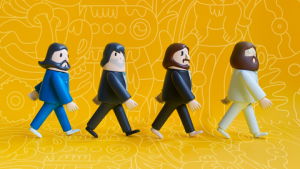 From novel and game figurines, to rock music, 3D printable figures are all the rage this week. If you are a Beatles fan or even have cursory exposure to iconic rock images, the photo of the four Beatles members — Paul McCartney, John Lennon, Ringo Starr, and George Harrison — crossing Abbey Road is one of the most widely reproduced and recognized rock photographs of the twentieth century. To commemorate the photo’s 46th anniversary, Taipei-based Bito has made available 3D printed Beatles dolls in partnership with “The Beatles, Tomorrow” exhibition. Bito launched a crowdfunding campaign for the Bitoy on Taiwanese crowdfunding website zeczec.com, and has raised four times more — about $46,000 USD — than planned in pledges 6 hours before the campaign closed. About $115 USD was enough to reserve a set of dolls, which are now sold out. Taking Bito by surprise, the popularity of these dolls speak to the Beatles’ ongoing popularity and the special imagery associated with the Abbey Road period — including that iconic album cover.
From novel and game figurines, to rock music, 3D printable figures are all the rage this week. If you are a Beatles fan or even have cursory exposure to iconic rock images, the photo of the four Beatles members — Paul McCartney, John Lennon, Ringo Starr, and George Harrison — crossing Abbey Road is one of the most widely reproduced and recognized rock photographs of the twentieth century. To commemorate the photo’s 46th anniversary, Taipei-based Bito has made available 3D printed Beatles dolls in partnership with “The Beatles, Tomorrow” exhibition. Bito launched a crowdfunding campaign for the Bitoy on Taiwanese crowdfunding website zeczec.com, and has raised four times more — about $46,000 USD — than planned in pledges 6 hours before the campaign closed. About $115 USD was enough to reserve a set of dolls, which are now sold out. Taking Bito by surprise, the popularity of these dolls speak to the Beatles’ ongoing popularity and the special imagery associated with the Abbey Road period — including that iconic album cover.
A DIY Voice-Controlled 3D Scanner Rig
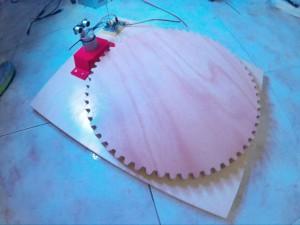 What do you get when you cross a sheet of cut plywood, a Lazy Susan bearing, a geared DC motor, and an Arduino microcontroller? That’s easy! It’s a voice-controlled/autonomous 3D scanning rig. The open source platform Instructables brings us this design from Aldric Negrier — a designer we have covered several times — who wanted to create a portable 3D scanning turntable (so one person can rotate it) with an autonomous voice-controlled scanning system. The smaller gear and its base can be 3D printed with files included on the Intsructables site, and the rest of the instructions are basic and straightforward. So, if having a voice-commanded rotating scanning turntable for one human body is on your wish list, you can make this dream a reality now.
What do you get when you cross a sheet of cut plywood, a Lazy Susan bearing, a geared DC motor, and an Arduino microcontroller? That’s easy! It’s a voice-controlled/autonomous 3D scanning rig. The open source platform Instructables brings us this design from Aldric Negrier — a designer we have covered several times — who wanted to create a portable 3D scanning turntable (so one person can rotate it) with an autonomous voice-controlled scanning system. The smaller gear and its base can be 3D printed with files included on the Intsructables site, and the rest of the instructions are basic and straightforward. So, if having a voice-commanded rotating scanning turntable for one human body is on your wish list, you can make this dream a reality now.
Scientists to Test 3D Printed Human Noses: On Sheep!
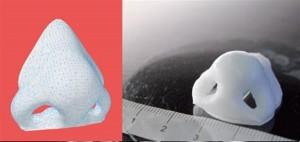 The next 3D printed item has much medical value, as Swedish scientists plan to test 3D printed nose implants out on sheep. Yes, you read that correctly. We know that great advances have been made in the field of 3D printed medical implants, so why not noses? 3D printed nose implant technology is ready for testing at ETH Zurich, the Swiss Federal Institute of Technology. These noses will feature bio structures such as joint cartilage, instead of the usual titanium or other metal. Developed by Marcy Zenobi-Wong and Matti Kesti, the implants are made of patients’ cartilage and biopolymers that will break down and be replaced by the patient’s own cells over time. Researchers report that all the biopolymers are replaced with cartilage cells within a few months, and there’s very little chance of rejection by the body.
The next 3D printed item has much medical value, as Swedish scientists plan to test 3D printed nose implants out on sheep. Yes, you read that correctly. We know that great advances have been made in the field of 3D printed medical implants, so why not noses? 3D printed nose implant technology is ready for testing at ETH Zurich, the Swiss Federal Institute of Technology. These noses will feature bio structures such as joint cartilage, instead of the usual titanium or other metal. Developed by Marcy Zenobi-Wong and Matti Kesti, the implants are made of patients’ cartilage and biopolymers that will break down and be replaced by the patient’s own cells over time. Researchers report that all the biopolymers are replaced with cartilage cells within a few months, and there’s very little chance of rejection by the body.
Biopolymers are finally reaching a stage where immune systems are growing much more tolerant of these foreign materials, which include seaweed-based acids and molecules developed by the body itself. Combined together, this 3D printable hydrogel, which includes human cells, has exactly the right consistency for 3D printing. But it is a very delicate process to print this material since cells can’t be damaged in the printing process. The nose implants will be initially tested on sheep — which were chosen as test subjects due to their size and physical constitution — before human tests can follow in a few years. The top recipients for such implants are people who need reconstructive facial surgery after facing cancer or a tragic accident that has severely impaired nose functioning.
3D Printed Hexacopter Drone Indiegogo Campaign
The Chinese company, ElecFreaks, that developed a pocket-sized  hexacopter drone with virtual reality compatibility last October, has now launched a successful crowdfunding campaign for their follow-up model. This would be the ELF: Open Share 3D-VR Nano Drone. In just a few crowdfunding days it has already raised 299% of its stated goal (as of the time of writing), and rising.
hexacopter drone with virtual reality compatibility last October, has now launched a successful crowdfunding campaign for their follow-up model. This would be the ELF: Open Share 3D-VR Nano Drone. In just a few crowdfunding days it has already raised 299% of its stated goal (as of the time of writing), and rising.
This success is not shocking since the drone design is very modular, fully hackable, and places an affordable “nanocopter with virtual reality capabilities” at everyone’s fingertips. ELF-VRDrone enables anyone to capture aerial videos and photos from the sky, because instead of relying on expensive Occulus Rift technology, it uses the cardboard toolkit-smartphone option. How does this work? You simply insert your smartphone into the cardboard goggle set. The drone’s files are open source, available on Thingiverse, and printable in either PLA or ABS plastic.
3D Printing to Benefit from New Plastics Labeling?
 Say you want to 3D print items using recycled plastic. The problem in the US is that our plastics are not labeled in detail, which means we don’t always know which plastics can be used in our 3D printers. The US recycling system lists only seven different label codes, while China, for example, differentiates between 140 types of polymers. Researchers at Michigan Technological University want to change this. In a paper titled “Polymer recycling codes for distributed manufacturing with 3-D printers,” China’s plastic code serves as inspiration for a proposed paradigm shift in the US regarding plastic labeling. Borrowing from China’s system, the research team has developed a new resin code identification system focusing on 3D printable polymers, which you can view here. This could be be the basis for a new recycling system, and this is precisely the researchers’ hope. It should be all of ours, really.
Say you want to 3D print items using recycled plastic. The problem in the US is that our plastics are not labeled in detail, which means we don’t always know which plastics can be used in our 3D printers. The US recycling system lists only seven different label codes, while China, for example, differentiates between 140 types of polymers. Researchers at Michigan Technological University want to change this. In a paper titled “Polymer recycling codes for distributed manufacturing with 3-D printers,” China’s plastic code serves as inspiration for a proposed paradigm shift in the US regarding plastic labeling. Borrowing from China’s system, the research team has developed a new resin code identification system focusing on 3D printable polymers, which you can view here. This could be be the basis for a new recycling system, and this is precisely the researchers’ hope. It should be all of ours, really.
MakerBot Announces New Flexible Financing Options
 Another great 3D printing hope has been the simple ability to get more printers into more people’s hands. It is difficult to argue against the idea that in order to make 3D printing more popular, the price of the machines must drop or more reasonable finance options need to be made available to otherwise enthusiastic consumers. MakerBot is doing just this as it has announced a partnership with Affirm and LEAF Commercial Capital. The idea is to offer buyers installment plans that allow them to pay off a 3D printer in 3-, 6-, or 12-month plans with 10-30% APR and an easy check out system. This idea first came about as MakerBot sought to create institutional buying options for schools, bundling printers, scanners, and filaments together for easier purchasing. Now it looks like the average customer has a better chance of owning their own printer, as new financing options are available to get the printers out of the warehouses and into the public’s hands.
Another great 3D printing hope has been the simple ability to get more printers into more people’s hands. It is difficult to argue against the idea that in order to make 3D printing more popular, the price of the machines must drop or more reasonable finance options need to be made available to otherwise enthusiastic consumers. MakerBot is doing just this as it has announced a partnership with Affirm and LEAF Commercial Capital. The idea is to offer buyers installment plans that allow them to pay off a 3D printer in 3-, 6-, or 12-month plans with 10-30% APR and an easy check out system. This idea first came about as MakerBot sought to create institutional buying options for schools, bundling printers, scanners, and filaments together for easier purchasing. Now it looks like the average customer has a better chance of owning their own printer, as new financing options are available to get the printers out of the warehouses and into the public’s hands.
BnK’s “Purement” is a PLA that Kills Germs
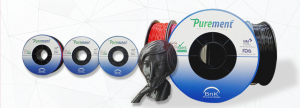 Finally, in filament news, South Korea-based BnK (Books and Kimchi) Chemical Corporation has been around since 2009 and has brought some innovative polymer materials to market. The company is now establishing itself as one of South Korea’s first manufacturers of FDM filament. Its latest addition is “PUREMENT” (“pure filament”), a PLA-based antibiotic/antimicrobial filament that uses durable inorganic antibacterial ingredients approved by the FDA and SIAA (Society of International Sustaining Growth for Antimicrobial Articles) for germ killing purposes. The filament’s antimicrobial effect was certified by KOLAS and eliminated 99% of the germs tested (colon bacillus and staphylococcus aureus). It has also passed other FDA tests. The material is also deemed non-toxic and is certified by Restriction of Hazardous Substances (RoHS), meaning that it doesn’t contain lead, mercury, cadmium, hexavalent chromium, polybrominated biphenyls, and polybrominated diphenyl ethers. BnK hopes to see this filament used to print toys, household goods, and other commonly used items where germs can thrive in tiny nooks and crannies.
Finally, in filament news, South Korea-based BnK (Books and Kimchi) Chemical Corporation has been around since 2009 and has brought some innovative polymer materials to market. The company is now establishing itself as one of South Korea’s first manufacturers of FDM filament. Its latest addition is “PUREMENT” (“pure filament”), a PLA-based antibiotic/antimicrobial filament that uses durable inorganic antibacterial ingredients approved by the FDA and SIAA (Society of International Sustaining Growth for Antimicrobial Articles) for germ killing purposes. The filament’s antimicrobial effect was certified by KOLAS and eliminated 99% of the germs tested (colon bacillus and staphylococcus aureus). It has also passed other FDA tests. The material is also deemed non-toxic and is certified by Restriction of Hazardous Substances (RoHS), meaning that it doesn’t contain lead, mercury, cadmium, hexavalent chromium, polybrominated biphenyls, and polybrominated diphenyl ethers. BnK hopes to see this filament used to print toys, household goods, and other commonly used items where germs can thrive in tiny nooks and crannies.
Some of PUREMENT’s specs include:
- Filament Net Weight : 0.6kg
- Material : PLA/ANTIMICOBIAL
- Diameter : 1.75mm, 2.85mm, 3mm
- Diameter Tolerance : ± 0.05 mm (Diameter Measurement)
- Print Temperature Guideline : 200°C ~ 230°C
- Validity Tolerance (max) : 0.05 mm
- Print Speed Guideline : 40 – 80 mm/s
That’s this week’s roundup of some of the goings-on in the 3D printing space! Let us know which of these piqued your interest in the Stories We Missed forum thread for this week over at 3DPB.com.
Subscribe to Our Email Newsletter
Stay up-to-date on all the latest news from the 3D printing industry and receive information and offers from third party vendors.
You May Also Like
3D Printing Unpeeled: New Arkema Material for HP, Saddle and Macro MEMS
A new Arkema material for MJF is said to reduce costs per part by up to 25% and have an 85% reusability ratio. HP 3D HR PA 12 S has been...
3D Printing News Briefs, January 20, 2024: FDM, LPBF, Underwater 3D Printer, Racing, & More
We’re starting off with a process certification in today’s 3D Printing News Briefs, and then moving on to research about solute trapping, laser powder bed fusion, and then moving on...
3D Printing Webinar and Event Roundup: December 3, 2023
We’ve got plenty of events and webinars coming up for you this week! Quickparts is having a Manufacturing Roadshow, America Makes is holding a Member Town Hall, Stratafest makes two...
Formnext 2023 Day Three: Slam Dunk
I’m high—high on trade show. I’ve met numerous new faces and reconnected with old friends, creating an absolutely wonderful atmosphere. The excitement is palpable over several emerging developments. The high...


